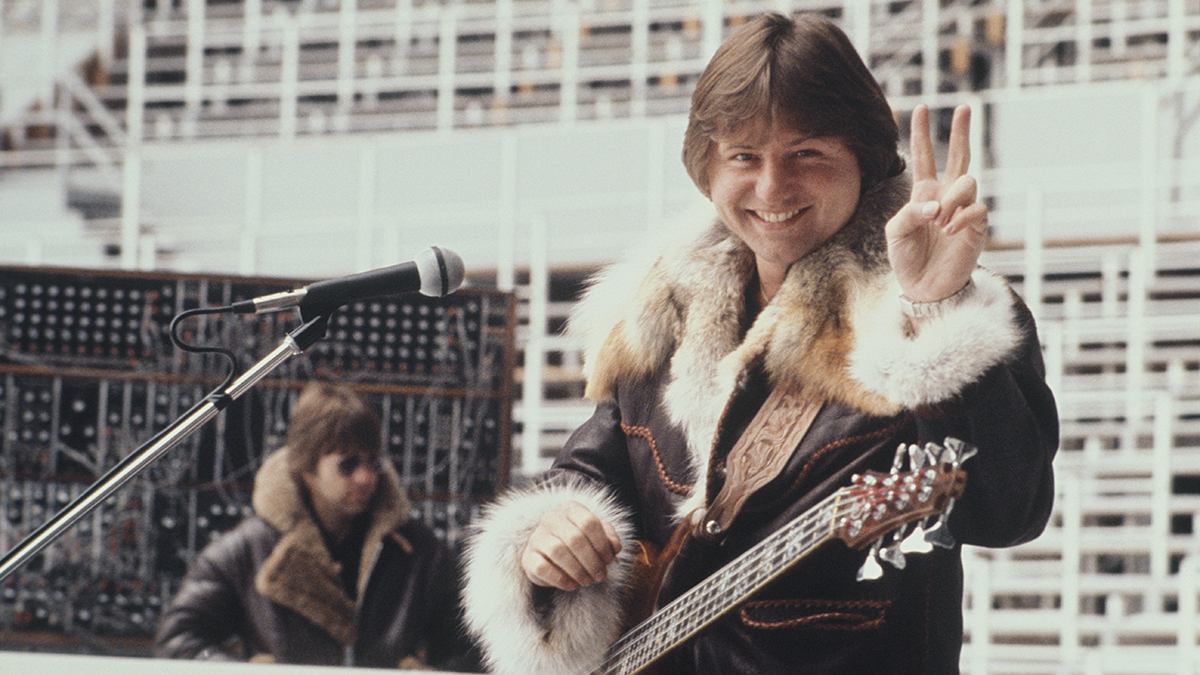The greatest delay moments of all time: 25 classic guitar tracks elevated by echo
The exemplars of echo, the doyens of digital and the analog innovators that made delay pedals a pedalboard perennial for guitar players
![[L-R] David Gilmour, Eddie Van Halen, St. Vincent and Brian May](https://cdn.mos.cms.futurecdn.net/PB6bGPmoAoifhtU9gRnRsR.jpg)
In 2021, the delay pedal is a pedalboard essential. But how did we get there? That there are so many flavors of delay is testimony to the ingenuity of the pedal-building industrial complex, but also to the creativity of the players who have found new ways of using the effect. To paraphrase Isaac Newton, we are standing on the pedalboards of giants.
The evolution of the delay pedal has been underway almost as soon as the electric guitar was first recorded. In the beginning, echo was used in much the same way as reverb. Set short, to slapback, it added a sense of depth and space. But soon players realized that it could be more than that.
Longer delay times and more repeats offered the opportunity for delay to distinguish itself from reverb. Here we are going to take a look at some of delay's best moments on record.
This being a list, there are omissions. We did not find room for Jimmy Page’s psychedelic freak-outs with the Echoplex and theremin. And yet we entered some guy by the name of Gilmour in twice. This list, like all lists, is not definitive, and it is not ordered. It’s simply 25 examples of some of the coolest things you can do with delay.
These applications needn’t foreground the delay pedal. You can, of course, set the delay, feedback (the number of repeats) and output level so that the delay will subtly thicken your tone, adding width to solos and buttressing a solo guitarist’s position in a band mix.
But sometimes it’s cool to lean into the features a little and do something showy, because if there is one pedal that can be all kinds of spectacular and offer a launchpad for off-piste audio adventures, it’s the delay – some of those new designs on the market will blow your mind.
So, in no particular order, here are 25 of the greatest delay moments of all time…
All the latest guitar news, interviews, lessons, reviews, deals and more, direct to your inbox!
1. Guns N’ Roses – Welcome to the Jungle
Guitarist: Slash
Greatest delay moments? Oh, shoot and heck! Let’s start with something that really is just a moment, an intro that stopped the clock for thousands of young players as Slash pulled us into the hedonistic nihilism of Guns N’ Roses’ incomparable debut, Appetite For Destruction.
This really is the delay as an effect, a pinch-hitting moment of audio-engineered voodoo to give the audience chills. Hearing this for the first time was to rock ’n’ roll what seeing Robert Patrick turn into liquid metal was in Terminator 2: Judgment Day. It is the perfect intro to the perfect album.
If Appetite was the acme of ‘80s rock hedonism – sleazy, nasty, dangerous – then the stabbed repeats here suggested the fracturing of morality and social decorum. “Abandon all hope ye who enter here, now, have a glass of room temperature Night Train Express and try to enjoy yourself…”
Primitive rock animal that he is, Slash was using a simple rig. There was his “Appetite ‘Burst” 1959 Les Paul Standard replica built by Kris Derrig, complete with a Seymour Duncan Alnico II humbucker at the bridge going into a non master volume Marshall Super Lead modded by Frank Levi and a Marshall 4x12.
It was producer Mike Clink who provided the delay via the Roland SRV-2000 Digital Reverb. That’s right, a rack-mounted reverb (hey, it was the ‘80s) with a secret delay mode. This digital easter egg was accessed by holding down the Reverb/Non Linear, Write and Room Simulate buttons as the unit is being powered on. Thereafter, set the delay time at 318ms feedback at 30, and output level to 50.

Gear pick: JHS 3 Series Delay
Slash packs a Boss DD-3 on his rig, but if you're a light user of delay and looking for an even more budget-friendly unit with switchable digital and analog-style delays, this is ideal.
2. Dead Kennedys – Holiday in Cambodia
Guitarist: East Bay Ray
Jello Biafra gets all the attention whenever people talk Dead Kennedys, but East Bay Ray was the real radical in the lineup. His tone and style was like the devil’s surf rock, a wiry, skronky tone that sounded like it was taken from a Spaghetti Western filmed in the Upside Down.
Key to his tone in those early recordings was a Maestro Echoplex placed first in the signal chain and using it as a pre-EQ effect. Typically, it would come afterwards, so that your distorted signal was being processed by the tape echo. Having it the other way around mean that the repeats would clean up a little as they faded, making it a little more disorientating for the audience.
You can hear this throughout Fresh Fruit for Rotting Vegetables, on which he’d run a Strat or humbucker-equipped Tele through a Fender Super Reverb, but Holiday in Cambodia showcases the full dynamic range of this tone – and of the Dead Kennedys’ mordant wit and anti-establishment posture.
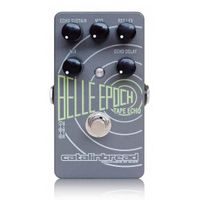
Gear pick: Catalinbread Belle Epoch
Run this EP-3-inspired digital tape delay into the front end of your amp – via a compressor for good measure – and keep the delay time short and play around with the repeats for some off-the-wall sounds.
3. David Bowie – Let’s Dance
Guitarist: Nile Rodgers
Let’s Dance is one of popular music’s greatest moments, let alone delays. Featuring both Nile Rodgers and Stevie Ray Vaughan – and, y’know, David Bowie – this is the apogee of high-concept pop.
As Nile Rodgers has explained, adding delay to his guitar part was something of an afterthought. There was strange anti-disco consensus at the time that was putting the zap on Rodgers’ typically funkifiable creative flow as he adapted Bowie’s original folk chord progression, but once he had evolved it into a jazzier piece, it was time for some studio magic to take over and give the lick its signature rhythmic bounce.
That's where the delay came in. Use a dual delay running two delay lines in parallel – preferably panned left and right in stereo – set one to an eighth note pulse (263ms) and the other to a quarter note (526ms), and, just as Rodgers says, “let the delay make the groove.”
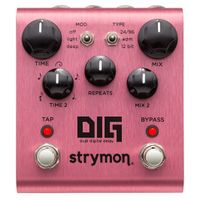
Gear pick: Strymon DIG Dual Digital Delay
As you might expect from the titan of digital effects, the DIG is eminently tweakable, and allows you to layer two delay engines in serial, parallel, or ping-pong – perfect for Let’s Dance.
4. Pink Floyd – Echoes
Guitarist: David Gilmour
No guitarist has done more to bend space and time to his will and promote the use of delay than David Gilmour. With Pink Floyd, he helped wrestle large, ambitious progressive rock songs out of the human semi-consciousness.
In the early days, his delay of choice was the Binson Echorec. The Echorec was a tube-driven echo unit that featured an analog magnetic drum recorder. You can hear throughout early Floyd, on tracks such as Time and Shine On You Crazy Diamond.
On Floyd’s Echoes: Live at Pompeii performance, Gilmour creates infinite violin sound with his slide, setting at around 310ms and using it to complement his Dallas Arbiter Fuzz Face, adding depth and sustain to his solo. One sure way to empty your bank account in a hurry is to buy a vintage Echorec online, but luckily you are living in the 21st century and there are some superlative digital alternatives.

Gear pick: Catalinbread Echorec
Offering all 12 head configurations of the original units, this compact digital replica is hugely versatile, easy to use and totally nails that old-school analog Binson magic.
5. Pink Floyd – Run Like Hell
Guitarist: David Gilmour
No guitarist has done more to bend space and time to his will and promote the use of delay than David Gilmour. With Pink Floyd… Oh no, wait! Sorry folks, but how else were we going to subvert the one artist, one entry rule for these lists but to insert a meta joke on delay?
This being David Gilmour’s world – and we’re all just lucky to be living in it – he gets a second entry, and it's significant, too, because having switching to an MXR Digital Delay in the late ‘70s, the flavor of his delay changed considerably.
More precise, more pristine, the digital delay was perfect for rhythmically complex licks such as Run Like Hell, where he is playing along with the repeats. It is a technique that was later expanded upon by the likes of Paul Reynolds, the Edge, Buckethead and others, but all of these players have their own unique take on it.
Run Like Hell was recorded in 1979, yet it still sounds exhilarating, provocative and new, the perfect early example of delay being used as an effect and compositional tool.
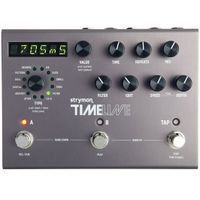
Gear pick: Strymon TimeLine
If you want to play Alice to Gilmour’s white rabbit, the industry standard for feature-packed digital delays will stand you in good stead.
6. Devin Townsend – Greetings
A sonic frontiersman with a taste for the theatrical, Devin Townsend was always going to make his way onto this list somehow. Throughout his discography, you will find ping pong delays, epic celestial delays, and a sound that feels like it made a reverse quantum leap to find itself on our timeline.
Found on the 1997 tour de force of prog metal, Greetings is one of those tracks where Hevy Devy’s tone assumes a quasi-utopian grandeur. It is immaculate and regal, a gift from the heavens.
It’s funny listening to this now; this came out in the ‘90s, before guitar culture’s digital transformation. Nowadays, Townsend uses a Fractal Axe-Fx III.
Of course, the entire Ocean Machine record is awash with clever and imaginative delays, so much so that Townsend’s signature Mooer delay/looper is named after it. There are more outré ways to use a delay but, here, it just sorts of gussies up the melody and gives it a patina of extra-terrestrial godliness.

Gear pick: Mooer Ocean Machine
The Ocean Machine lets you choose from 15 types of delay and run two independent delay lines, run it with reverb, through the looper, and go full-on Devy and run your rig in stereo.
7. Eric Johnson – Cliffs of Dover
Eric Johnson had his admirers before the release of Ah Via Musicom, but his cresting compositional nous and a most delicious, Michelin Starred tone helped the 1990 release catapult him into the consciousness and practice regime of nigh-on every guitar nerd on the planet.
It is an album of many highlights, but Cliffs Of Dover is the one that can be heard from outer space, and remains one of the hallowed touchstones of instrumental guitar music. It is of particular interest here as an example of delay – or in this instance Echoplex tape echo – taking on an emulsifying effect on his tone.
You will not necessarily taste it, but without it the creamy, violin sauce of Johnson’s hyper-melodic arrangements would have split. Johnson’s rig on Cliffs Of Dover saw him put his guitar through a Maestro Echoplex, then into a Chandler Tube Driver, and into a 100-watt Marshall half stack.
The unorthodox echo-into-overdrive signal chain – really it’s like using a spoon to eat steak – evened out the delay/echo effect for an ambient effect during busier passages, and offered a more traditional three-dimensionality during his more restrained moments.
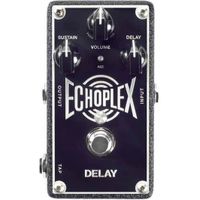
Gear pick: Dunlop EP103 Echoplex Delay Pedal
A compact and effective Echoplex clone, the EP103 has simple three-knob setup with a push/pull function on the volume control for “aging” your repeats.
8. Queen – Brighton Rock
Guitarist: Brian May
The orchestral galaxy brain nestled safely underneath Dr May’s curly locks is never too far from breaking out with a show-topping rock overture. Queen’s oeuvre was forever bursting at the seams of rock ’n’ roll, the majesty of their voluminous songwriting imagination expanding our musical vocabularies with each passing release, and it sometimes felt as though May’s harmonized lead guitar could only be replicated in science fiction.
As it turned out, May felt that way, too, and for live performances, where he somehow had to replicate the studio magic, he turned to the Echoplex for an answer.
Indeed, he turned to two Echoplex units, to be precise. Running them both with the same delay time and each into their own amplifier to avoid unwanted modulation, he could make his Brighton Rock a widescreen Technicolor supernova that defied physical law.
All in all, you’ll need three Vox AC30s, two vintage Echoplex units (in working condition), a guitar built from the May homestead’s fireplace, and a splitter box – run the guitar into its own amp, take the signal from that into the splitter box and send that through their own individual Vox AC30s, and you’re good to go. Oh! And use a sixpence as a pick. Easy, right?
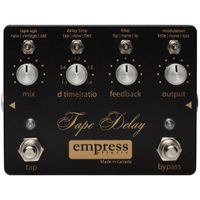
Gear pick: Empress Effects Tape Delay
If Brian May’s live rig is a little impractical for the home, a fully featured tape echo should at least give you some joy for recording your own overdubs, and this from Empress makes an incredible launchpad for your own adventures with the effect.
9. U2 – Where the Streets Have No Name
Guitarist: The Edge
Go out to your garden, hang U2’s discography from the tree and throw a dart blindfolded. You’ll be all but guaranteed to hit a song that exemplifies how delay can be used in a musical context. Just as Van Gogh used oil on canvas, the Edge uses the electric guitar through a cornucopia of delay pedals.
He has used the likes of the Korg SDD-3000, TC Electronic 2290 Dynamic Digital Delay, the AMS SDMX Digital Delay and more, but it is not really a question of what he uses as how he uses.
Where the Streets Have No Name – which, as the great Billy Connolly once joked, is about a mailman with the blues – is all bobbing, kinetic rhythmic repeats, dotted eighths on the repeats and populating the mix with a wall of guitars.
Again, like May, the Edge is using delay to sell the illusion that there are more guitars onstage, each perfectly in time on an intricately composed rhythm measure.
Pedal culture has truly exploded in recent years, and the internet allied to a new generation of circuit designers has played its part, but its tracks such as this that demonstrate just how a well-curated pedalboard and some imagination can create a signature sound that resonates far beyond guitar culture.
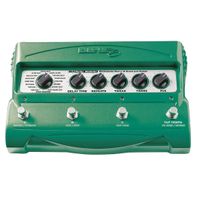
Gear pick: Line 6 DL4
There are any number of “Edge presets” on digital modeling amp user boards but the DL4 remains an industry standard, and has all the tools you need to get creative with rhythmic repeats.
10. Allan Holdsworth – House of Mirrors
We will remember the late jazz-rock fusion trailblazer Allan Holdsworth for many things. For some it will be for chord voicings so complex they were like a four-person game of Twister.
Others are all in for his unique phrasing, or his gift for legato solo runs and his poly-modal scalar vocabulary. But he was a gear pioneer, too, and not only for his long association with headless Steinberger electric guitars and the SynthAxe, but for stacking of delays to engineer some of the most immersive clean tones recorded.
Having used units such as the Yamaha D1500, Roland SDE-3000, Lexicon PCM-42, and the DeltaLab Effectron, Holdsworth set about paring down the rig, working with Yamaha on the UD-Stomp delay. Programmable and capable of running eight delays – four short with modulation, four long with mod and feedback controls – the UD-Stomp allowed Holdsworth to use delay very differently.
Often he would use a volume pedal for dramatic swells, but one of the benefits of his multi-delay approach was he could use delay a little like reverb but with none of the washy ambience that you might get from using a long reverb.
Hall of Mirrors is a great example of all things Holdsworth – particularly the chord voicings – but particularly for those sumptuous clean tones, given depth and width with multi-tapped delay.
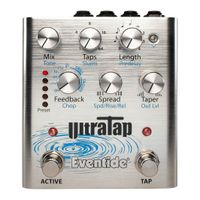
Gear pick: Eventide UltraTap multi-tap delay
No, it’s not cheap and you’d lose a holiday weekend just to fathom half of its functions, but Eventide has put together something very special here, ideal for those epic Holdsworth tones and a lot more.
Jonathan Horsley has been writing about guitars since 2005, playing them since 1990, and regularly contributes to publications including Guitar World, MusicRadar and Total Guitar. He uses Jazz III nylon picks, 10s during the week, 9s at the weekend, and shamefully still struggles with rhythm figure one of Van Halen’s Panama.

